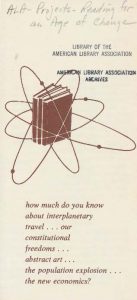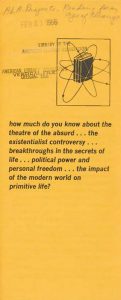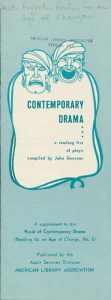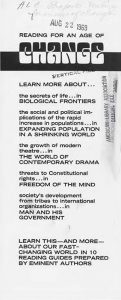From at least 1961 through 1966, the series title Reading for an Age of Change was advertised through a fun variety of bookmarks which can also be fun for determining their elusive publication dates. Read on to learn more about dating ephemeral publications and advertising for Reading for an Age of Change!
Stored in the a separate record series the Reading for an Age of Change, there are at least five different promotional bookmarks which describe the publication series. While not all of our holdings for publications and publication series include promotional materials like advertisements, such ephemeral documents help archivists and other researchers understand the promotional context of these publications. At the same time, ephemeral items are not designed with long-term archival storage in mind. Not only are these items often composed of materials which decay faster than the publications which they promote, if these items are donated to an archives then they are often undated too. Archivists and other researchers can estimate an approximate date of publication for ephemeral items, by using clues in the document.
In our first example, printed in 1961, the orange bookmark above describes the upcoming series while featuring the new series’ logo of a book surrounded by electrons in orbit. While this document is dated at the bottom of the page, key terms like “new series” or “new reading program” help archivists determine an approximate date of publication for the item. If the series is new and we know that the first book was published in 1960, then we can reasonably estimate that this bookmark was printed around the year 1960. Conveniently for us, this bookmark includes a 1961 print date. When compared against the
Research tip: Often, promotional materials like bookmarks can be dated by convenient publication dates at the bottom of the document.
In our second example, also printed early in the series’ history, the white bookmark describes the series logo of a book surrounded by electrons in orbit. This bookmark invites readers into intellectual content of the publication series by referencing the interesting questions raised by the series titles. While there is no print date for this bookmark, the use of the original series logo and the specific references to series titles are clues that this might have been published during the first half of the reading program’s life, because the document is inviting readers to join a current conversation about the intellectual topics.
In our third example, we have no date. Careful readers will notice that an office time stamp is impressed upon the top of the document. These markings indicate not when a document was published but when a document was received by an office. Since we know that these promotional bookmarks were all received by the ALA Headquarters Library, because they are stored in the Library’s office files, we can infer from the time stamp that the office received this bookmark (but not necessarily its peers) in 1966. This bookmark also announces new publication titles which are not found in the previous bookmarks. Now, we can use this bookmark as a reference tool to help approximate the dates of other undated items too.
Research tip: Time stamps on office documents indicate when an item was received and not when an item was printed.
In our fourth example, we have a blue bookmark with classical Greek theater motifs of tragedy and comedy above a notice of a new title publication. While the document has no date or time stamp, we have a clue listed in the series title listed. Since this bookmark is about Number 6: Contemporary Drama, then we can estimate the date of this document to be from the time of the book’s publication in 1966.
Research tip: Sometimes, the content of an ephemeral item is directly linked to a historical event which can greatly narrow the possible date range of its publication.
Finally, in our last example, we have a white bookmark which announces the names of book series topics. Using what we have learned in the previous examples, we have at least three indicators to guide us. First, the titles listed are from the second installment of the series which must be around 1966. Also, secondly, we see Contemporary Drama listed which is also evidence for an approximately 1966 date. Finally, at the top of the document, we see an office time stamp which tells us that an office received the document in 1969. If we had to make a conservative guess for a date of publication, then we might list this item as published circa 1966, which means that within a range of time of a few years before (or after) 1966, this bookmark might have been printed.
Copies Available at Your ALA Archives
Physical copies of Reading for an Age of Change advertisements are available for viewing at the ALA Archives. Please view the Record Series 12/1/15 database record entry, for more information.
Got Something to Donate to the Story So Far?
Many people have been involved in the long history of A.L.A. publications and bibliographic work. Do you have any information about Reading for an Age of Change participants, collaborators, publications, or beneficiaries? Please contact us through social media. We and our readers would like to read about it.




